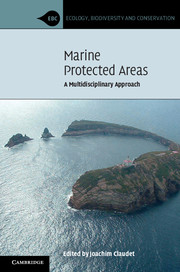Book contents
- Frontmatter
- Contents
- Contributors
- Introduction
- Part I Threats to marine ecosystems and resources
- Part II Effects of marine protected areas
- Part III Assessment of the effectiveness of marine protected areas
- Part IV Scale-up of marine protected area systems
- 11 NETWORKS – The assessment of marine reserve networks: guidelines for ecological evaluation
- 12 CONNECTIVITY – Spacing a network of marine protected areas based on connectivity data
- 13 REPRESENTATIVENESS – Effectiveness of the global network of marine protected areas
- 14 MISSING DIMENSION – Conserving the largest habitat on Earth: protected areas in the pelagic ocean
- Index
- References
12 - CONNECTIVITY – Spacing a network of marine protected areas based on connectivity data
from Part IV - Scale-up of marine protected area systems
Published online by Cambridge University Press: 05 August 2012
- Frontmatter
- Contents
- Contributors
- Introduction
- Part I Threats to marine ecosystems and resources
- Part II Effects of marine protected areas
- Part III Assessment of the effectiveness of marine protected areas
- Part IV Scale-up of marine protected area systems
- 11 NETWORKS – The assessment of marine reserve networks: guidelines for ecological evaluation
- 12 CONNECTIVITY – Spacing a network of marine protected areas based on connectivity data
- 13 REPRESENTATIVENESS – Effectiveness of the global network of marine protected areas
- 14 MISSING DIMENSION – Conserving the largest habitat on Earth: protected areas in the pelagic ocean
- Index
- References
Summary
Introduction
Networks of marine protected areas (MPAs) have been widely advocated for the conservation of marine biodiversity (see Figure 12.1). Such a conceptual framework assumes marine species as capable of dispersal that will interconnect patches of protected marine habitat. However, in order for MPA networks to be successful in protecting marine populations, individual MPAs must be self-sustaining or adequately connected to other MPAs via dispersal.
There are different views on the connectivity of marine fish populations. The distinction may partially be due to the different spatial and temporal scales being considered, as well as related to expectations of managers and stakeholders (Hilborn et al., 2004; Ojeda-Martinez et al., 2009). For example, managers of MPAs, when referring to connectivity, may be most interested in movement of juveniles and adults at small spatial scales (leading to spillover: Roberts et al., 2001; Stobart et al., 2009), while fisheries scientists may be most interested in the dispersal potential of eggs and larvae produced within the MPA at much larger spatial scales. Some biological oceanographers may refer to connectivity in the context of retention by physical processes near a reef, while others may explore physical processes that lead to dispersal events through geological time among many reefs. Ecologists may be interested in changes in biodiversity arising from range extensions, while this type of connectivity may simply be viewed by an evolutionary biologist as a small part of a cycle of range extension and extirpation on the margins of species’ ranges.
- Type
- Chapter
- Information
- Marine Protected AreasA Multidisciplinary Approach, pp. 322 - 333Publisher: Cambridge University PressPrint publication year: 2011



